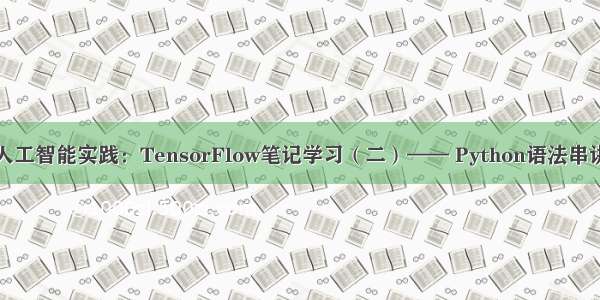
大纲
7.1 复现已有的卷积神经网络
7.2 用vgg16实现图片识别
目标
掌握复现已有网络,用vgg16实现图片识别
7.1复现已有的卷积神经网络
VGGNet是Karen simonyan等人在的ICLR会议中,公开的神经网络模型。这个模型在的ImageNet比赛中获得了定位第一名和分类第二名的成绩。论文为VeryDeep Convolutional Networks for Large-Scale Image Recognition,这篇博客对该论文介绍的非常详细。这篇文章是以比赛为目的——解决ImageNet中的1000类图像分类和localization。作者对六个网络的实验结果在深度对模型影响方面,进行了感性分析(越深越好),实验结果是16和19层的VGGNet(VGG代表了牛津大学的Oxford Visual Geometry Group,该小组隶属于1985年成立的Robotics Research Group,该Group研究范围包括了机器学习到移动机器人)分类和localization的效果好。
VGG实现代码重点讲解
x =tf.placeholder(tf.float32,shape =[BATCH_SIZE,IMAGE_PIXELS])
tf.placeholder:用于传入真实训练样本/测试/真实特征/待处理特征。只是占位,不必给出初值。
用sess.run的feed_dict参数以字典形式喂入x:, y_: sess.run(feed_dict = {x: ,y_: })
BATCH_SIZE:一次传入的个数。 IMAGE_PIXELS:图像像素。
例:x = tf.placeholder("float",[1,224,224,3])
BATCH_SIZE为1,表示一次传入一个。图像像素为[224,224,3]。
w =tf.Variable(tf.random_normal()):从正态分布中给出权重w的随机值。
b = tf.Variable(tf.zeros()):统一将偏置b初始化为0。
注意:以上两行函数Variable中的V要大写,Variable必须给初值。
np.loadnp.save:将数组以二进制格式保存到磁盘,扩展名为.npy 。
.item():遍历(键值对)。
tf.shape(a)和a.get_shape()比较
相同点:都可以得到tensor a的尺寸
不同点:tf.shape()中 a 的数据类型可以是 tensor, list, array;
而a.get_shape()中a的数据类型只能是tensor,且返回的是一个元组(tuple)。
例:import tensorflow as tf
import numpy as np
x=tf.constant([[1,2,3],[4,5,6]]
y=[[1,2,3],[4,5,6]]
z=np.arange(24).reshape([2,3,4]))
sess=tf.Session() #tf.shape()
x_shape=tf.shape(x)
#x_shape 是一个tensor
y_shape=tf.shape(y)#<tf.Tensor 'Shape_2:0'shape=(2,) dtype=int32>
z_shape=tf.shape(z)# <tf.Tensor 'Shape_5:0'shape=(3,) dtype=int32>
print sess.run(x_shape) # 结果:[2 3]
print sess.run(y_shape) # 结果:[2 3]
print sess.run(z_shape) # 结果:[2 3 4]
#a.get_shape()
x_shape=x.get_shape() # 返回的是 TensorShape([Dimension(2),Dimension(3)]),不能使用 sess.run(),因为返回的不是tensor 或string,而是元组
x_shape=x.get_shape().as_list() #可以使用 as_list()得到具体的尺寸,x_shape=[2 3]
y_shape=y.get_shape() # AttributeError: 'list' object hasno attribute 'get_shape'
z_shape=z.get_shape() #AttributeError: 'numpy.ndarray' object has no attribute 'get_shape'
tf.nn.bias_add(乘加和,bias):把bias加到乘加和上。
tf.reshape(tensor, shape):
改变tensor的形状
# tensor ‘t’ is [1, 2, 3, 4, 5, 6, 7, 8, 9]
# tensor ‘t’ has shape [9] reshape(t, [3, 3])==>
[[1, 2, 3],
[4, 5, 6],
[7, 8, 9]]
#如果shape有元素[-1],表示在该维度打平至一维
# -1 将自动推导得为 9:
reshape(t, [2, -1]) ==>
[[1, 1, 1, 2, 2, 2, 3, 3, 3],
[4, 4, 4, 5, 5, 5, 6, 6, 6]]
np.argsort(列表):对列表从小到大排序。
OS模块 os.getcwd():返回当前工作目录。
os.path.join(path1[,path2[,......]]):
返回值:将多个路径组合后返回。 注意:第一个绝对路径之前的参数将被忽略。
例:
>>>import os
>>> vgg16_path = os.path.join(os.getcwd(),"vgg16.npy")
#当前目录/vgg16.npy,索引到vgg16.npy文件
np.save:写数组到文件(未压缩二进制形式),文件默认的扩展名是.npy 。
np.save("名.npy",某数组):将某数组写入“名.npy”文件。
某变量 =np.load("名.npy",encoding= " ").item():将“名.npy”文件读出给某变量。
encoding = " " 可以不写‘latin1’、‘ASCII’、‘bytes’,默认为’ASCII’。例:
>>> import numpy as np
A = np.arange(15).reshape(3,5)
>>> A array([[ 0,1, 2, 3,4], [ 5, 6,7, 8, 9], [10, 11, 12, 13,14]])
>>> np.save("A.npy",A)#如果文件路径末尾没有扩展名.npy,该扩展名会被自动加上。
>>> B=np.load("A.npy")
>>> B array([[ 0,1, 2, 3,4], [ 5, 6,7, 8, 9], [10, 11, 12, 13,14]])
tf.split(dimension,num_split, input):
dimension:输入张量的哪一个维度,如果是0就表示对第0维度进行切割。
num_split:切割的数量,如果是2就表示输入张量被切成2份,每一份是一个列表。 例:
import tensorflow as tf; import numpyas np;
A = [[1,2,3],[4,5,6]] x = tf.split(1,3, A)
with tf.Session() as sess:
c = sess.run(x) for ele in c: print ele
输出:
[[1]
[4]]
[[2]
[5]]
[[3]
[6]]
tf.concat(concat_dim, values):
沿着某一维度连结tensor:
t1 = [[1, 2, 3], [4, 5, 6]]
t2 = [[7, 8, 9], [10, 11, 12]]tf.concat(0, [t1, t2]) ==> [[1, 2, 3], [4, 5, 6], [7, 8, 9], [10, 11,12]]
tf.concat(1, [t1, t2]) ==>[[1, 2, 3, 7, 8, 9], [4, 5, 6, 10, 11, 12]]
如果想沿着tensor一新轴连结打包,那么可以:
tf.concat(axis, [tf.expand_dims(t,axis) for t in tensors]) 等同于tf.pack(tensors, axis=axis)
fig = plt.figure("图名字"):实例化图对象。
ax = fig.add_subplot(mn k):将画布分割成m行n列,图像画在从左到右从上到下的第k块。
例: #引入对应的库函数
import matplotlib.pyplot as plt from numpy import *
#绘图
fig = plt.figure() ax = fig.add_subplot(3 4 9)ax.plot(x,y)
plt.show()
ax.bar(bar的个数,bar的值,每个bar的名字,bar的宽,bar的颜色):绘制直方图。给出bar的个数,bar的值,每个bar的名字,bar的宽,bar的颜色。
ax.set_ylabel(""):给出y轴的名字。ax.set_title(""):给出子图的名字。
ax.text(x,y,string,fontsize=15,verticalalignment="top",horizontalalignment="right"):
x,y:表示坐标轴上的值。 string:表示说明文字。 fontsize:表示字体大小。
verticalalignment:垂直对齐方式,参数:[ ‘center’ | ‘top’ | ‘bottom’| ‘baseline’ ]
horizontalalignment:水平对齐方式,参数:[‘center’ | ‘right’ | ‘left’ ]
xycoords选择指定的坐标轴系统:
•figure pointspoints from the lower left of the figure 点在图左下方
• figure pixelspixels from the lower left of the figure 图左下角的像素
• figure fractionfraction of figure from lower left 左下角数字部分
•axes pointspoints from lower left corner of axes 从左下角点的坐标
•axes pixelspixels from lower left corner of axes 从左下角的像素坐标
•axesfraction
fraction of axes from lower left 左下角部分
•data use the coordinatesystem of the object being annotated(default) 使用的坐标系统被注释的对象(默认)
•polar(theta,r)
•ifnot native ‘data’ coordinates t arrowprops #箭头参数,参数类型为字典dict
•width the width of the arrow in points点箭头的宽度
• headwidth the widthof the base of the arrow head in points 在点的箭头底座的宽度
•headlength the lengthof the arrow head in points 点箭头的长度
•shrink fraction of total length to ‘shrink’from both ends 总长度为分数“缩水”从两端
•facecolor 箭头颜色bbox给标题增加外框 ,常用参数如下:
•boxstyle方框外形
•facecolor(简写fc)背景颜色
•edgecolor(简写ec)边框线条颜色
• edgewidth边框线条大小
bbox=dict(boxstyle='round,pad=0.5',fc='yellow',ec='k',lw=1,alpha=0.5) #fc为facecolor,ec为edgecolor,lw为lineweight
plt.show():画出来。
axo = imshow(图):画子图。
图 = io.imread(图路径索引到文件)。
7.2 用vgg16实现图片识别
vgg网络具体结构
VGG源码包含的文件主要有app.py,vgg16.py,utils.py,Nclasses.py,vgg16.npy.
app.py:应用程序,实现图像识别
#coding:utf-8import numpy as npimport tensorflow as tf#引入绘图模块import matplotlib.pyplot as plt#引用自定义模块import vgg16import utilsfrom Nclasses import labelstestNum = input("input the number of test pictures:")for i in range(testNum):img_path = raw_input('Input the path and image name:')#对待测试图像出预处理操作img_ready = utils.load_image(img_path) #定义画图窗口,并指定窗口名称fig=plt.figure(u"Top-5 预测结果") with tf.Session() as sess:#定义一个维度为[1, 224, 224, 3]的占位符images = tf.placeholder(tf.float32, [1, 224, 224, 3])#实例化出vggvgg = vgg16.Vgg16() #前向传播过程,调用成员函数,并传入待测试图像vgg.forward(images) #将一个batch数据喂入网络,得到网络的预测输出probability = sess.run(vgg.prob, feed_dict={images:img_ready})#得到预测概率最大的五个索引值top5 = np.argsort(probability[0])[-1:-6:-1]print "top5:",top5#定义两个list-对应概率值和实际标签values = []bar_label = []#枚举上面取出的五个索引值for n, i in enumerate(top5): print "n:",nprint "i:",i#将索引值对应的预测概率值取出并放入valuevalues.append(probability[0][i]) #将索引值对应的际标签取出并放入bar_labelbar_label.append(labels[i]) print i, ":", labels[i], "----", utils.percent(probability[0][i]) #将画布分为一行一列,并把下图放入其中ax = fig.add_subplot(111) #绘制柱状图ax.bar(range(len(values)), values, tick_label=bar_label, width=0.5, fc='g')#设置横轴标签ax.set_ylabel(u'probabilityit') #添加标题ax.set_title(u'Top-5') for a,b in zip(range(len(values)), values):#显示预测概率值ax.text(a, b+0.0005, utils.percent(b), ha='center', va = 'bottom', fontsize=7) #显示图像plt.show()
vgg16.py:读模型参数,搭建模型
#!/usr/bin/python#coding:utf-8import inspectimport osimport numpy as npimport tensorflow as tfimport timeimport matplotlib.pyplot as plt#样本RGB的平均值VGG_MEAN = [103.939, 116.779, 123.68] class Vgg16():def __init__(self, vgg16_path=None):if vgg16_path is None:#返回当前工作目录vgg16_path = os.path.join(os.getcwd(), "vgg16.npy") #遍历其内键值对,导入模型参数self.data_dict = np.load(vgg16_path, encoding='latin1').item() def forward(self, images):print("build model started")#获取前向传播开始时间start_time = time.time() #逐个像素乘以255rgb_scaled = images * 255.0 #从GRB转换彩色通道到BRGred, green, blue = tf.split(rgb_scaled,3,3) #减去每个通道的像素平均值,这种操作可以移除图像的平均亮度值#该方法常用在灰度图像上bgr = tf.concat([blue - VGG_MEAN[0],green - VGG_MEAN[1],red - VGG_MEAN[2]],3)#构建VGG的16层网络(包含5段卷积,3层全连接),并逐层根据命名空间读取网络参数#第一段卷积,含有两个卷积层,后面接最大池化层,用来缩小图片尺寸self.conv1_1 = self.conv_layer(bgr, "conv1_1") #传入命名空间的name,来获取该层的卷积核和偏置,并做卷积运算,最后返回经过激活函数后的值self.conv1_2 = self.conv_layer(self.conv1_1, "conv1_2")#根据传入的pooling名字对该层做相应的池化操作self.pool1 = self.max_pool_2x2(self.conv1_2, "pool1")#第二段卷积,包含两个卷积层,一个最大池化层self.conv2_1 = self.conv_layer(self.pool1, "conv2_1")self.conv2_2 = self.conv_layer(self.conv2_1, "conv2_2")self.pool2 = self.max_pool_2x2(self.conv2_2, "pool2")#第三段卷积,包含三个卷积层,一个最大池化层self.conv3_1 = self.conv_layer(self.pool2, "conv3_1")self.conv3_2 = self.conv_layer(self.conv3_1, "conv3_2")self.conv3_3 = self.conv_layer(self.conv3_2, "conv3_3")self.pool3 = self.max_pool_2x2(self.conv3_3, "pool3")#第四段卷积,包含三个卷积层,一个最大池化层self.conv4_1 = self.conv_layer(self.pool3, "conv4_1")self.conv4_2 = self.conv_layer(self.conv4_1, "conv4_2")self.conv4_3 = self.conv_layer(self.conv4_2, "conv4_3")self.pool4 = self.max_pool_2x2(self.conv4_3, "pool4")#第五段卷积,包含三个卷积层,一个最大池化层self.conv5_1 = self.conv_layer(self.pool4, "conv5_1")self.conv5_2 = self.conv_layer(self.conv5_1, "conv5_2")self.conv5_3 = self.conv_layer(self.conv5_2, "conv5_3")self.pool5 = self.max_pool_2x2(self.conv5_3, "pool5")#第六层全连接#根据命名空间name做加权求和运算self.fc6 = self.fc_layer(self.pool5, "fc6")#经过relu激活函数self.relu6 = tf.nn.relu(self.fc6) #第七层全连接self.fc7 = self.fc_layer(self.relu6, "fc7")self.relu7 = tf.nn.relu(self.fc7)#第八层全连接self.fc8 = self.fc_layer(self.relu7, "fc8")self.prob = tf.nn.softmax(self.fc8, name="prob")#得到全向传播时间end_time = time.time() print(("time consuming: %f" % (end_time-start_time)))#清空本次读取到的模型参数字典self.data_dict = None #定义卷积运算 def conv_layer(self, x, name):#根据命名空间name找到对应卷积层的网络参数with tf.variable_scope(name): #读到该层的卷积核w = self.get_conv_filter(name) #卷积运算conv = tf.nn.conv2d(x, w, [1, 1, 1, 1], padding='SAME') #读到偏置项conv_biases = self.get_bias(name) #加上偏置,并做激活计算result = tf.nn.relu(tf.nn.bias_add(conv, conv_biases)) return result#定义获取卷积核的参数def get_conv_filter(self, name):#根据命名空间从参数字典中获取对应的卷积核return tf.constant(self.data_dict[name][0], name="filter") #定义获取偏置项的参数def get_bias(self, name):#根据命名空间从参数字典中获取对应的偏置项return tf.constant(self.data_dict[name][1], name="biases")#定义最大池化操作def max_pool_2x2(self, x, name):return tf.nn.max_pool(x, ksize=[1, 2, 2, 1], strides=[1, 2, 2, 1], padding='SAME', name=name)#定义全连接层的全向传播操作def fc_layer(self, x, name):#根据命名空间name做全连接层的计算with tf.variable_scope(name): #获取该层的维度信息列表shape = x.get_shape().as_list() dim = 1for i in shape[1:]:#将每层的维度相乘dim *= i #改变特征图的形状,也就是将得到的多维特征做拉伸操作,只在进入第六层全连接层做该操作x = tf.reshape(x, [-1, dim])#读到权重值w = self.get_fc_weight(name) #读到偏置项值b = self.get_bias(name) #对该层输入做加权求和,再加上偏置result = tf.nn.bias_add(tf.matmul(x, w), b) return result#定义获取权重的函数def get_fc_weight(self, name): #根据命名空间name从参数字典中获取对应1的权重return tf.constant(self.data_dict[name][0], name="weights")
utils.py:读入图片,概率显示
#!/usr/bin/python#coding:utf-8from skimage import io, transformimport numpy as npimport matplotlib.pyplot as pltimport tensorflow as tffrom pylab import mplmpl.rcParams['font.sans-serif']=['SimHei'] # 正常显示中文标签mpl.rcParams['axes.unicode_minus']=False # 正常显示正负号def load_image(path):fig = plt.figure("Centre and Resize")#传入读入图片的参数路径img = io.imread(path) #将像素归一化处理到[0,1]img = img / 255.0 #将该画布分为一行三列,把下面的图像放在画布的第一个位置ax0 = fig.add_subplot(131) #添加子标签ax0.set_xlabel(u'Original Picture') #添加展示该图像ax0.imshow(img) #找到该图像的最短边short_edge = min(img.shape[:2]) #把图像的w和h分别减去最短边,并求平均y = (img.shape[0] - short_edge) / 2 x = (img.shape[1] - short_edge) / 2 #取出切分过的中心图像crop_img = img[y:y+short_edge, x:x+short_edge] #把下面的图像放在画布的第二个位置ax1 = fig.add_subplot(132) #添加子标签ax1.set_xlabel(u"Centre Picture") #添加展示该图像ax1.imshow(crop_img)#resize成固定的imagesizere_img = transform.resize(crop_img, (224, 224)) #把下面的图像放在画布的第三个位置ax2 = fig.add_subplot(133) ax2.set_xlabel(u"Resize Picture") ax2.imshow(re_img)#转换为需要的输入形状img_ready = re_img.reshape((1, 224, 224, 3))return img_ready#定义百分比转换函数def percent(value):return '%.2f%%' % (value * 100)
Nclasses.py:含lables字典,共1000个标签
vgg16.npy:网络参数,训练好的参数模型
app.py运行预测结果
致谢
感谢曹老师的辛勤付出,来源曹健,人工智能实践:TensorFlow笔记,北京大学
网址:/course/PKU-1002536002
代码地址:/caoxiaoliang/tensorflow-learning/tree/master/code/Tensorflow%208%20%20vgg















